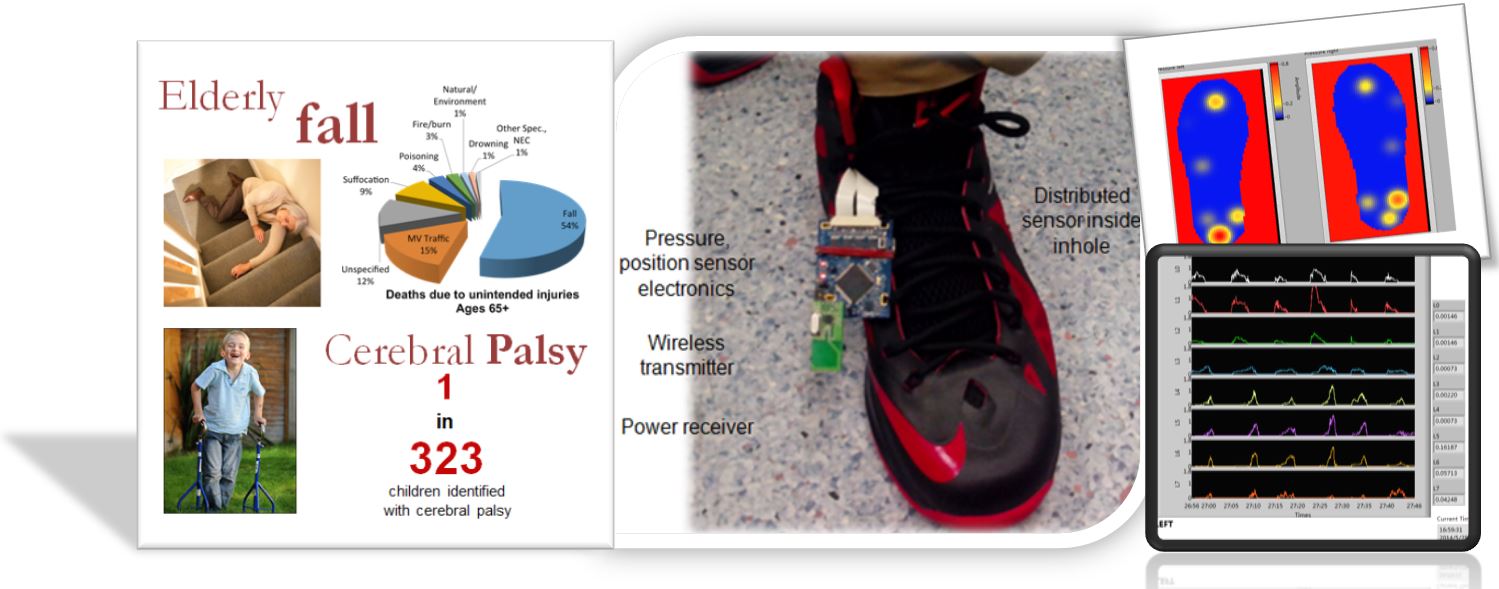Wearable Electronics and System in Healthcare and Lifestyle Applications
Research Overview
We are working on the following wearable devices:
Headset: a portable real-time infrared lids, iris and blink (PRILIB) monitoring system for diagnosis of ocular myasthenia gravis - in collaboration with National University Hospital, Singapore.
Headset: a portable, light weighted pupil tracker to evaluate drowsiness and fatigue - in collaboration with Defense Science Organization, Singapore.
Portable sensor: a self-calibrated system to measure intraocular pressure for glaucoma patients treatment with drugs - in collaboration with National University Hospital.
Shoe: FreeWalker - a smart insole for continuous foot pressure monitoring and motion tracking - in collaboration with the SeSaMe Center at Interactive Digital Media Institute, Singapore.
A Headset for Blepharoptosis Diagnosis and Fatigue Prediction

- Blepharoptosis
- defined as abnormal drooping of the upper eyelid, is a common problem affecting all ages and ethnicities. It is one of the most common eyelid disorders encountered in ophthalmology. Its prevalence has been reported to be approximately 11.5% in a population over 50 years old, which increases with age. Although a vast majority of the ptosis is senile in origin, a certain percentage of the cases are associated with systemic diseases, and may signal the presence of more serious underlying neurological disorders. Treatment depends on the underlying etiology of the ptosis, and for ptosis cases with a systemic association, early and correct diagnosis is of paramount importance. While determining the cause of ptosis is essential for individualization of patient management, it is sometimes difficult to elicit the cause of the ptosis even with thorough history, examination, and workup. Investigations such as serum antibodies, tensilon test, and electromyography are being used currently to aid in diagnosis, each has its own set of limitations such as invasiveness (insertion of electrode needles into the extraocular muscles), lack of sensitivity, and potential risks and side effects.
We see a compelling opportunity to address the current limitations of medical knowledge in the diagnosis of ptosis mechanisms. Hence we have developed a Portable Real-time Infrared Lids, Iris and Blink (PRILIB) monitoring device, with the primary goal to improve the clinical diagnosis of ptosis, and secondarily for other conditions. We have accomplished a pilot clinical trial and obtained positive results of clinical significance and feedbacks for technology revision. We are improving the PRILIB (e.g. to have wireless data link integrated, two-tier signal processing) and applying it into a larger scale trial in collaboration with ophthalmologists at NUH including Drs. Clement Tan and Stephanie Young, Victor Koh among others.
Fatigue Detection/Prediction

Eye fatigue is a problem that could cause chronic eye problems, degradation in life quality and accidents which could lead to death (car accidents, work related accidents). We have discovered through trials and analyzing the pupil cycle frequency, that we can preemptively detect the onset of fatigue that could help in alerting a person that he/she needs to rest before slipping into sleep or micro sleep. By recording the pupil using a video recorder and using an image processing algorithm to detect the pupil dilation cycle frequency, we have discovered that there is an increase in power between 0.1 Hz to 1 Hz a few minutes before a person is going to enter sleep or micro sleep. In the future, we will use this discovery and another method of objectifying fatigue to objectively detect the degree of fatigue.
Smart-shoes for Fall Detection and Pathological Gait Diagnosis

Unmet Needs
- Fall is the leading cause of death in elderly people, responsible for more than 50% of accidental deaths in people 65 years old or above. It is also estimated that one third of elderly persons living in community and 60% of those living in nursing home experience at least 1 fall each year. Fall detection can reduce morbidity in elderly population.
- Cerebral palsy patients often have walking disorder, caused by abnormal muscle tone. This can lead to slow walking, worsen stability, soft tissue contracture or even joint deformity. A smart shoe can help them walk better.
In the current prototype, there are 16 disk shaped pressure sensors inserted inside an insole. Each sensor is connected to a low noise instrumentation amplifier and the amplified/filtered signals are then sampled 1000 times per second. A microcontroller (MCU) has been used for signal processing and interfacing with peripheral circuits (wireless, USB interface, power management circuits, and accelerometer). The data can be stored or wirelessly transmitted to a computer, where the transmission distance is up to 20 meters. Once charged the battery can support continuous operation of more than 8 hours with full bandwidth data transmission.